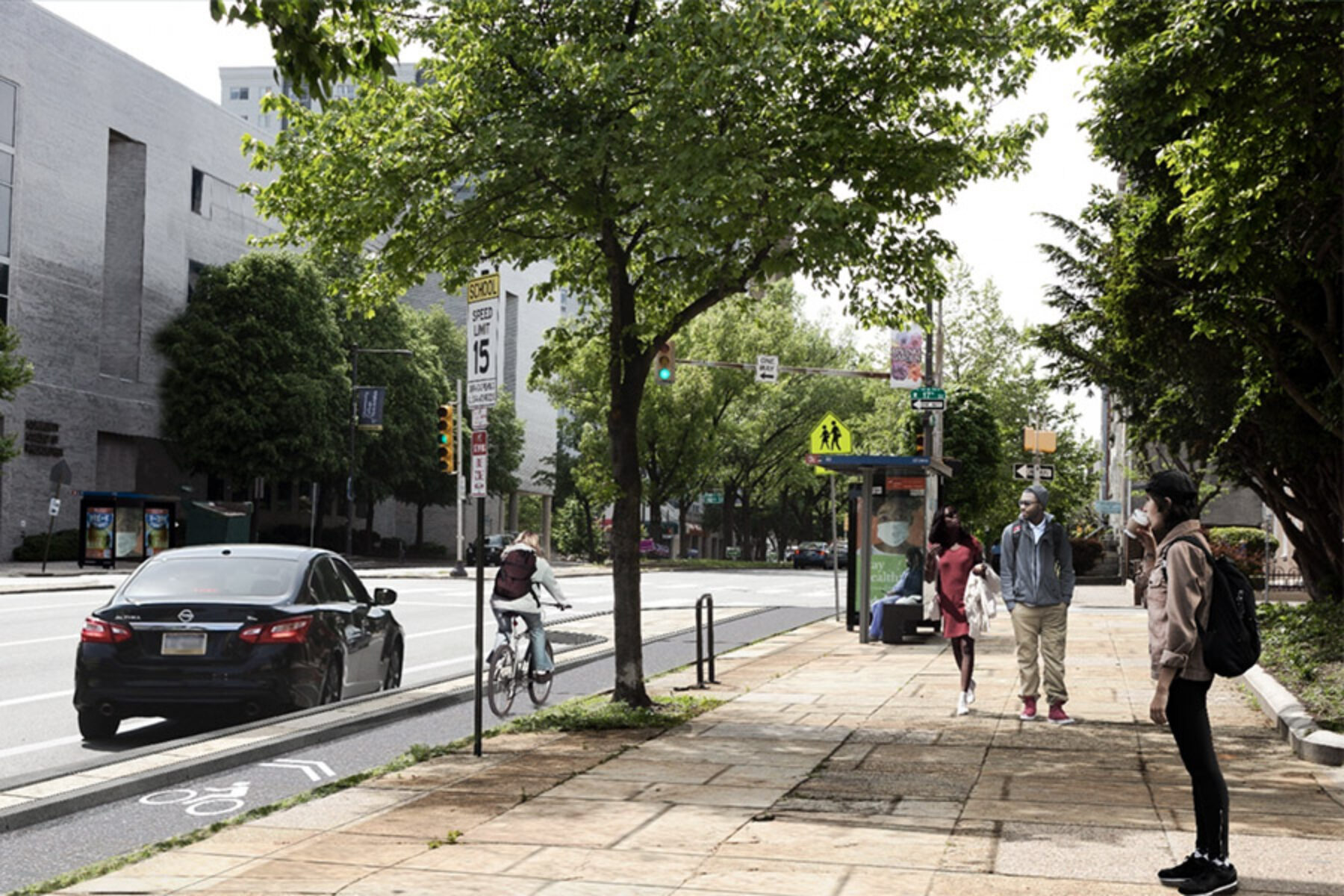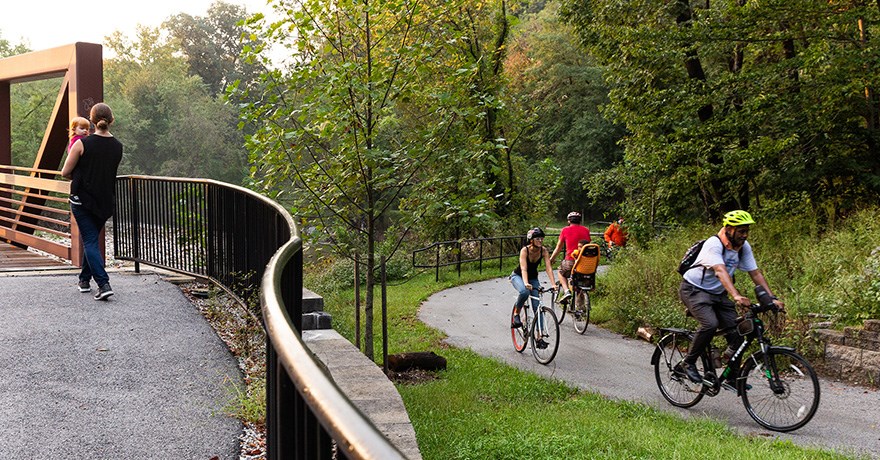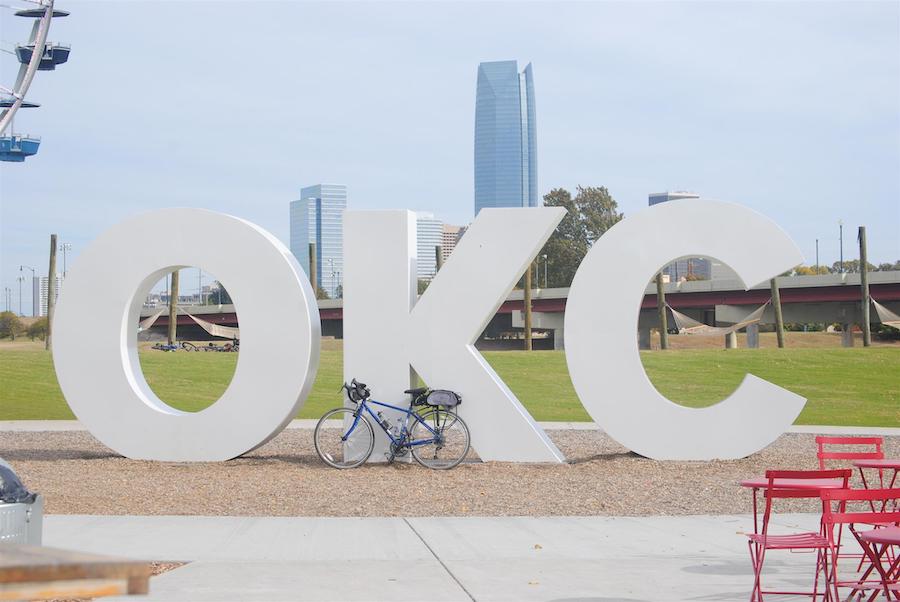Leveraging Active Transportation to Meet State Carbon Reduction and Climate Goals

When the Bipartisan Infrastructure Law passed, new programs were introduced to support states in their efforts to keep people safe on our roadways and to reduce emissions. We’ve seen many of these programs prioritize investments in connected trails and active transportation networks, demonstrating a growing understanding in America that when we make it safer and more convenient for people to walk and bike, this infrastructure delivers transformative transportation outcomes.
Now, we’re beginning to see the impact of another of these programs, the Carbon Reduction Program, which provides $6.4 billion in formula funds over five years and mandates that states develop carbon reduction strategies designed to reduce transportation emissions from on-road highway sources.
When the program was introduced, RTC pointed to the potential for walking and bicycling to contribute significantly to its impact. States can effectively lower their emissions by leveraging the program to support these zero-carbon forms of transportation, while also realizing myriad other benefits for the well-being of their constituents. Many states have now publicly released their Carbon Reduction Program strategies, and it seems they’re taking note of the role that walking and biking can serve in addressing the climate impacts of transportation: 40 state plans include references to increased walking and biking as a strategy for lowering emissions. In several states, funding is already flowing to support critical infrastructure projects that will create more walkable, bikeable regions.

A Landmark Investment in Pennsylvania

In the greater Philadelphia region, the Circuit Trails network will one day connect over 800 miles of multiuse trails—creating safe transportation routes and spaces for people to be active outside in their communities. Over 400 miles of the trail network are complete, but there are gaps that have proven difficult to develop out that interrupt the functionality of the active transportation infrastructure in some areas.
County commissioners from across the region saw the Carbon Reduction Program as an opportunity to address these gaps, with the potential to provide the large-scale funding needed.
In July, the Delaware Valley Regional Planning Commission, which is the metropolitan planning organization (MPO) for the region, voted to include $120 million in Carbon Reduction Program funding for four major active-transportation corridors—the Spring Garden Street Greenway, the Cross County Trail, the Chester Valley Trail and the Route 291 Trail/East Coast Greenway—through its FY 2025 Transportation Improvement Program. This is the largest investment of federal carbon reduction funding to date in active transportation projects, demonstrating how this program can be leveraged to accelerate the development of trail and active transportation networks.
“This landmark investment in trail networks underscores how important walking and biking infrastructure is to helping people across our region get around without a car,” said Patrick Starr, chair of the Circuit Trails Coalition. “The Circuit Trails network is proving that we can prioritize [these investments], which do make a difference to the health of people and the planet.”
Active Transportation Bridging Politics

RTC analyzed the publicly available state Carbon Reduction Program plans, identifying notable examples of how states are prioritizing trails and active transportation in their strategies to reduce emissions and meet climate goals. It’s noteworthy that these examples come from states across the country, bridging progressive and conservative politics. The inclusion and often emphasis of active transportation in these plans represents the relevance and impact of trails and active transportation across the political spectrum, as well as the widespread recognition of the role trails, walking and biking play in lowering transportation emissions. Highlights include the following:
- Oklahoma’s strategy is committed to exploring “opportunities to coordinate with MPOs and Rural Transportation Planning Organizations to examine the connections between land use and transit planning, including pedestrian and bicycle connections to transit routes.”
- Arkansas’ strategy highlights active transportation as one of its carbon reduction goals, including identifying multiple trail and active transportation projects listed as priorities for Arkansas’ various MPOs. The Arkansas Department of Transportation (ARDOT) plan encourages multimodal coordination, which “helps integrate transit, bicycle and pedestrian modes into the overall transportation network and reduce demand for trips by personal vehicle.”
- Washington State’s strategy referred to its investment of carbon reduction program funds in active transportation, stating that as of the release of the strategy document, about $16.4 million has been programmed, with nearly 50% of the funding going to active transportation projects. WSDOT also highlights active transportation and land use in its strategies to move people and goods more efficiently and equitably, stating that “land use strategies improve multimodal accessibility and safety, reduce the distance single occupancy vehicles must travel, and enhance freight efficiency,” and “active transportation strategies make walking, biking, and using transit, attractive, practical, and safe to use.”
States Pointing to Mode Shift as a Carbon Reduction Strategy

In reviewing the state Carbon Reduction Program plans, RTC found that over 30 of them documented the importance of mode shift (i.e., shifting car trips to walking, biking or using public transportation) and reducing vehicle miles traveled as important to reducing emissions. These states acknowledge that shifting transportation away from driving and toward active transportation and public transit is important to their carbon reduction strategies—in many cases for the first time and in states from across the political spectrum. This acknowledgement of shifting transportation to low/zero emission modes should be seen as progress in the long effort to evolve away from solely focusing on the needs of drivers. A sampling of plans that address mode shift are as follows:
- Mississippi’s strategy refers to active transportation and reducing vehicle miles traveled as “strategies that encourage users to take trips via nonvehicular modes, such as active transportation or public transit,” including bicycle and pedestrian facilities, public transit, first and last mile connections, and micromobility. The plan states that “a robust active transportation network helps decrease congestion, particularly on local and collector roads. Bike and pedestrian facilities also help improve public image and provide options for those without vehicle access.”
- Nebraska’s strategy explicitly highlights the importance of “mode shift to less carbon intensive travel options by enhancing multimodal transportation services, partnerships, and infrastructure.” The plan also states that “active mobility plans, including biking, walking, and trail expansion,” will help with mode shift and make “transportation more people-centered and reduce reliance on cars.”
- Maine’s plan states that “reducing the number of vehicle miles traveled is another key strategy to reducing emissions in the transportation sector, identified in the state’s climate action plan. Although MaineDOT can’t ask drivers to use their vehicles less, the department can provide drivers with the choice of alternative modes of transportation.”
- West Virginia’s plan says that “as vehicle miles traveled continue rising, it will become increasingly important to provide a variety of multimodal options for passenger and freight trips. As passenger and freight vehicle miles traveled continue to rise (and outpace increases in fuel efficiency), the transportation system will need to make use of a toolkit of strategies to reduce vehicle miles traveled, improve safety, combat congestion, and extend the useful life of the state’s roadways. Many of the eligible programs within the Carbon Reduction Program support reducing vehicle miles traveled or lessening its impact, reducing carbon emissions. These include technological solutions … or alternative mode projects like pedestrian and bicycle pathways and transit.”
Maximizing the Opportunity

In RTC’s first analysis of the Carbon Reduction Program (CRP), we identified that all projects eligible under the Transportation Alternatives (TA) program—including construction, planning and design—are also eligible for this funding, illustrating a recognition by Congress of the transformative impact that active transportation can play in carbon reduction and mode shift. Some states have transferred CRP funding directly into their TA programs, like Ohio’s DOT, and have begun funding trail and active transportation projects.
This is one step you can take to engage with your state DOT and MPOs, encouraging them consider either transferring carbon reduction funds to TA or spending these funds on planning or building trails.
Action Steps You Can Take
Consider putting CRP funds directly into Transportation Alternatives:
- Some states have chosen to transfer CRP funds directly into TA programs, thus increasing available funds for projects. As mentioned above, TA-eligible projects are also eligible for CRP funding. TA is the largest dedicated funding source for trails, walking and biking, and a vast majority of TA funds now flow to those eligibilities. Transferring funds to TA is administratively convenient and ensures CRP investment in these important projects. Transferring funding in this way also creates more opportunities for active transportation networks in creating mode shift and reducing carbon emissions.
When choosing projects to fund, focus on connectivity and safety:
- When administering funding, states and MPOs often assess which projects have the biggest impact in carbon reduction. To ensure a significant impact, RTC recommends that decision-makers prioritize active transportation networks and connectivity to everyday destinations, such as public transit, schools or business hubs. We also recommend prioritizing traffic-separated infrastructure to ensure walking and biking are safe and popular for all ages and abilities.
- Some states have chosen to score projects on a points system and allot additional points for active transportation projects that are traffic-separated and/or are located close to public transportation. This adjustment is an easy change that would result in better-connected and safer projects.
- By emphasizing safety and connectivity in projects, decision-makers can feel confident that more users will choose biking and walking, thus lowering emissions significantly and contributing to modeshift.
Focus on community engagement and clear application criteria:
- There were multiple states and MPOs that underwent significant community engagement processes to develop their CRP strategies. By engaging in robust community engagement, you can ensure that plans are supported by the community and that various stakeholders understand the importance and benefits of trails and active transportation. You can also help increase your supporter base and stimulate advocacy for further CRP investment in trails, walking and biking.
- It is imperative to create a transparent and clear application process to ensure all eligible applicants understand when and how to apply, and how different criteria will be weighed and scored. As mentioned above, we recommend the application criteria include safety and connectivity, as well as an estimated impact on carbon reduction, so applicants can focus on these prioritized elements in projects and applications. Being transparent about the process and how to succeed will help increase the number of applications and make projects more impactful.
Consider running one larger funding cycle to support larger projects:
- Rather than using funds each year, MPOs and states can consider pooling funding for one or two application cycles to fund larger projects. By saving up annual allotments of CRP funds and combining them into larger cycles, CRP can support the development and completion of sizeable and/or more expensive and harder to fund projects that could have a major impact on both carbon reduction outcomes and connectivity.
Include trail and active transportation networks as key components of CRP strategies:
- As state DOTs create their carbon reduction plans, it’s imperative that active transportation is a core part of their CRP strategies. (We have seen multiple states do this as part of their November submissions.)
- By focusing on trails, walking and biking in strategies, states are showing that they recognize active transportation as critical to mode shift and the establishment of sustainable transportation in America.
Source: The Critical Role of Active Transportation in the Federal Carbon Reduction Program
The Carbon Reduction Program is incentivizing states to examine transportation choices through an emissions reduction lens, which creates a significant opportunity to showcase the role that trails and active transportation can and should play in reducing emissions and helping states meet their carbon reduction goals. It is encouraging to see how many state DOTs are already including walking and biking infrastructure in their plans for lowering emissions, which, in turn, could have a lasting impact for how states prioritize investments in trails, walking and biking.

Donate
Everyone deserves access to safe ways to walk, bike, and be active outdoors.